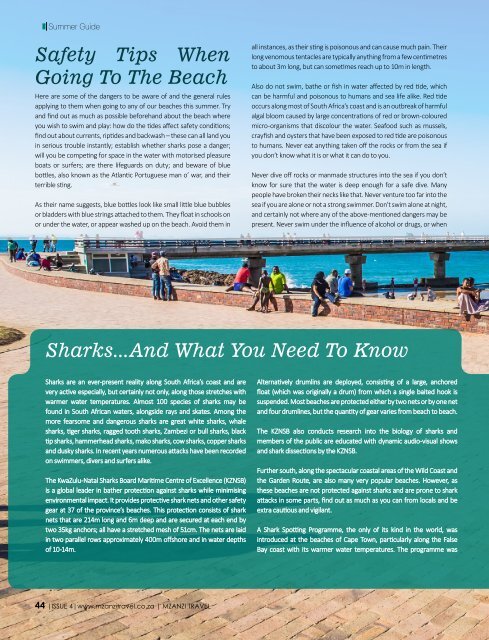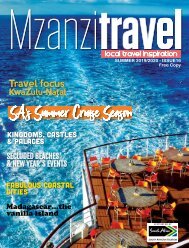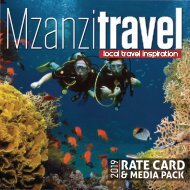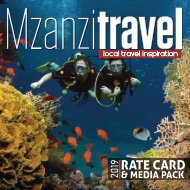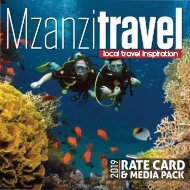You also want an ePaper? Increase the reach of your titles
YUMPU automatically turns print PDFs into web optimized ePapers that Google loves.
Explore Summer Africa Guide<br />
Safety Tips When<br />
Going To The Beach<br />
Here are some of the dangers to be aware of and the general rules<br />
applying to them when going to any of our beaches this summer. Try<br />
and find out as much as possible beforehand about the beach where<br />
you wish to swim and play: how do the tides affect safety conditions;<br />
find out about currents, riptides and backwash – these can all land you<br />
in serious trouble instantly; establish whether sharks pose a danger;<br />
will you be competing for space in the water with motorised pleasure<br />
boats or surfers; are there lifeguards on duty; and beware of blue<br />
bottles, also known as the Atlantic Portuguese man o’ war, and their<br />
terrible sting.<br />
As their name suggests, blue bottles look like small little blue bubbles<br />
or bladders with blue strings attached to them. They float in schools on<br />
or under the water, or appear washed up on the beach. Avoid them in<br />
all instances, as their sting is poisonous and can cause much pain. Their<br />
long venomous tentacles are typically anything from a few centimetres<br />
to about 3m long, but can sometimes reach up to 10m in length.<br />
Also do not swim, bathe or fish in water affected by red tide, which<br />
can be harmful and poisonous to humans and sea life alike. Red tide<br />
occurs along most of South Africa’s coast and is an outbreak of harmful<br />
algal bloom caused by large concentrations of red or brown-coloured<br />
micro-organisms that discolour the water. Seafood such as mussels,<br />
crayfish and oysters that have been exposed to red tide are poisonous<br />
to humans. Never eat anything taken off the rocks or from the sea if<br />
you don’t know what it is or what it can do to you.<br />
Never dive off rocks or manmade structures into the sea if you don’t<br />
know for sure that the water is deep enough for a safe dive. Many<br />
people have broken their necks like that. Never venture too far into the<br />
sea if you are alone or not a strong swimmer. Don’t swim alone at night,<br />
and certainly not where any of the above-mentioned dangers may be<br />
present. Never swim under the influence of alcohol or drugs, or when<br />
Sharks...And What You Need To Know<br />
Sharks are an ever-present reality along South Africa’s coast and are<br />
very active especially, but certainly not only, along those stretches with<br />
warmer water temperatures. Almost 100 species of sharks may be<br />
found in South African waters, alongside rays and skates. Among the<br />
more fearsome and dangerous sharks are great white sharks, whale<br />
sharks, tiger sharks, ragged tooth sharks, Zambezi or bull sharks, black<br />
tip sharks, hammerhead sharks, mako sharks, cow sharks, copper sharks<br />
and dusky sharks. In recent years numerous attacks have been recorded<br />
on swimmers, divers and surfers alike.<br />
The KwaZulu-Natal Sharks Board Maritime Centre of Excellence (KZNSB)<br />
is a global leader in bather protection against sharks while minimising<br />
environmental impact. It provides protective shark nets and other safety<br />
gear at 37 of the province’s beaches. This protection consists of shark<br />
nets that are 214m long and 6m deep and are secured at each end by<br />
two 35kg anchors; all have a stretched mesh of 51cm. The nets are laid<br />
in two parallel rows approximately 400m offshore and in water depths<br />
of 10-14m.<br />
Alternatively drumlins are deployed, consisting of a large, anchored<br />
float (which was originally a drum) from which a single baited hook is<br />
suspended. Most beaches are protected either by two nets or by one net<br />
and four drumlines, but the quantity of gear varies from beach to beach.<br />
The KZNSB also conducts research into the biology of sharks and<br />
members of the public are educated with dynamic audio-visual shows<br />
and shark dissections by the KZNSB.<br />
Further south, along the spectacular coastal areas of the Wild Coast and<br />
the Garden Route, are also many very popular beaches. However, as<br />
these beaches are not protected against sharks and are prone to shark<br />
attacks in some parts, find out as much as you can from locals and be<br />
extra cautious and vigilant.<br />
A Shark Spotting Programme, the only of its kind in the world, was<br />
introduced at the beaches of Cape Town, particularly along the False<br />
Bay coast with its warmer water temperatures. The programme was<br />
44 |ISSUE 4|www.mzanzitravel.co.za | MZANZI TRAVEL


